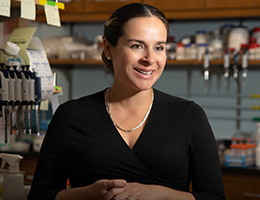Elsy Buitrago-Delgado
 Why did you choose Northwestern?
Why did you choose Northwestern?
Northwestern University is well known as a competitive institution. Northwestern is ranked among the best universities in the U.S., and has one of the most extraordinary and innovative research programs in biology in the country. The Interdisciplinary Biological Sciences Graduate Program IBiS was one of the unique places I found to foster collaborative work across different disciplines.
How would you describe your research and/or work to a non-academic audience? What was it then and/or what is it now?
My graduate research proposed and tested a novel hypothesis about the origin of Neural Crest Cells (NCCs) and their relationship to Embryonic Stem Cells (ESCs). NCCs are multipotent progenitors unique to vertebrates that give rise to a variety of cells that are part of the peripheral nervous system, the craniofacial skeleton and skin among many others. NCCs were thought to arise in the ectoderm during development, due to a transient de-differentiation in which the cells “regain” the developmental potential that allows them to later differentiate into multiple fates that are unique to vertebrates. However, I found evidence suggesting that, instead of transiently de-differentiating, NCCs evolved due to a developmental retention of the pluripotency gene regulatory network, which prolongs their developmental potential during vertebrate embryogenesis. I demonstrated that, rather than regaining such potential, NCCs shared a molecular program that maintains pluripotency in both NCCs and ESCs. Together these findings represent a paradigm shift in our understanding of the origin of NCC potency. Since the neural crest is a vertebrate-defining trait, this new model also changed how we view vertebrate evolution. Finally, my findings have also extended our knowledge of how ESCs maintain pluripotency, by describing the network that controls pluripotency has many more elements that we previously realized and this network can be reused in different developmental processes to control pluripotency. As result, my work may ultimately facilitate harnessing the differentiation potential of both ESCs and NCCs in regenerative medicine.
Tell us who or what inspired your research and/or work.
Being born in Colombia – South America, one of the most diverse countries in the world, made me amaze of the diversity of forms, shapes and species of animals and plants that we can find in the Andean forests. Since very early in my career I became passionate to understand where the diversity of cell types that comprise our organism originates and what are the molecular mechanisms underlying the transition from pluripotent to multipotent to differentiated cells. I am focusing my efforts to understand how the fertilized egg gives rise to a complex multicellular organism. Many people have inspired my work but mainly Nicolas Pelaez Restrepo a developmental biologist from Colombia who did his PhD at Northwestern University, and two Chilean theoretical biologists, Humberto Maturana and Francisco Varela and their work “ de máquinas y seres vivos”
What are you most proud of in your career to date?
I am very proud to be a Latinx scientist who came to USA looking for opportunities to solve the basic biological questions that I had since I was an undergrad in my hometown university in Tunja-Colombia. I am proud of the teamwork we did at the LaBonne Lab and the publication from 2015 on the origin of the neural crest cells. I am also very proud of the HHMI Hanna H Gray Fellowship that I got for my postdoctoral studies in the Cai Lab at Caltech, I am extremely proud to be named as one of the 100 inspiring Hispanic/Latinx scientist in America in the category of rising stars.
Tell us about a current achievement or something you're working on that excites you.
I am currently working to understand early embryogenesis using sequential in situ hybridization (seq-FISH) in pre-implatantion mouse embryos. This spatial transcriptomics technique will allow us to see thousands of mRNAs at the same time in the same embryo while preserving the spatial context. My main goal is to build the first quantitative transcriptome-wide spatial-temporal atlas of early embryogenesis, This map would reveal how changes in RNA abundance and spatial distribution control the sequence of events regulating early animal development in situ, and how misregulation of RNA distribution leads to developmental abnormalities and disease.
What advice would you give your younger self or someone considering a similar path?
I have two main messages for the young scientist: be persistent, work hard and despite all the doors seems to be closed keep looking for opportunities that will take you where you want to go. Don’t give up you can do it! / Follow your instincts, follow your heart, read a wide range of scientific papers no matter if it is your expertise.